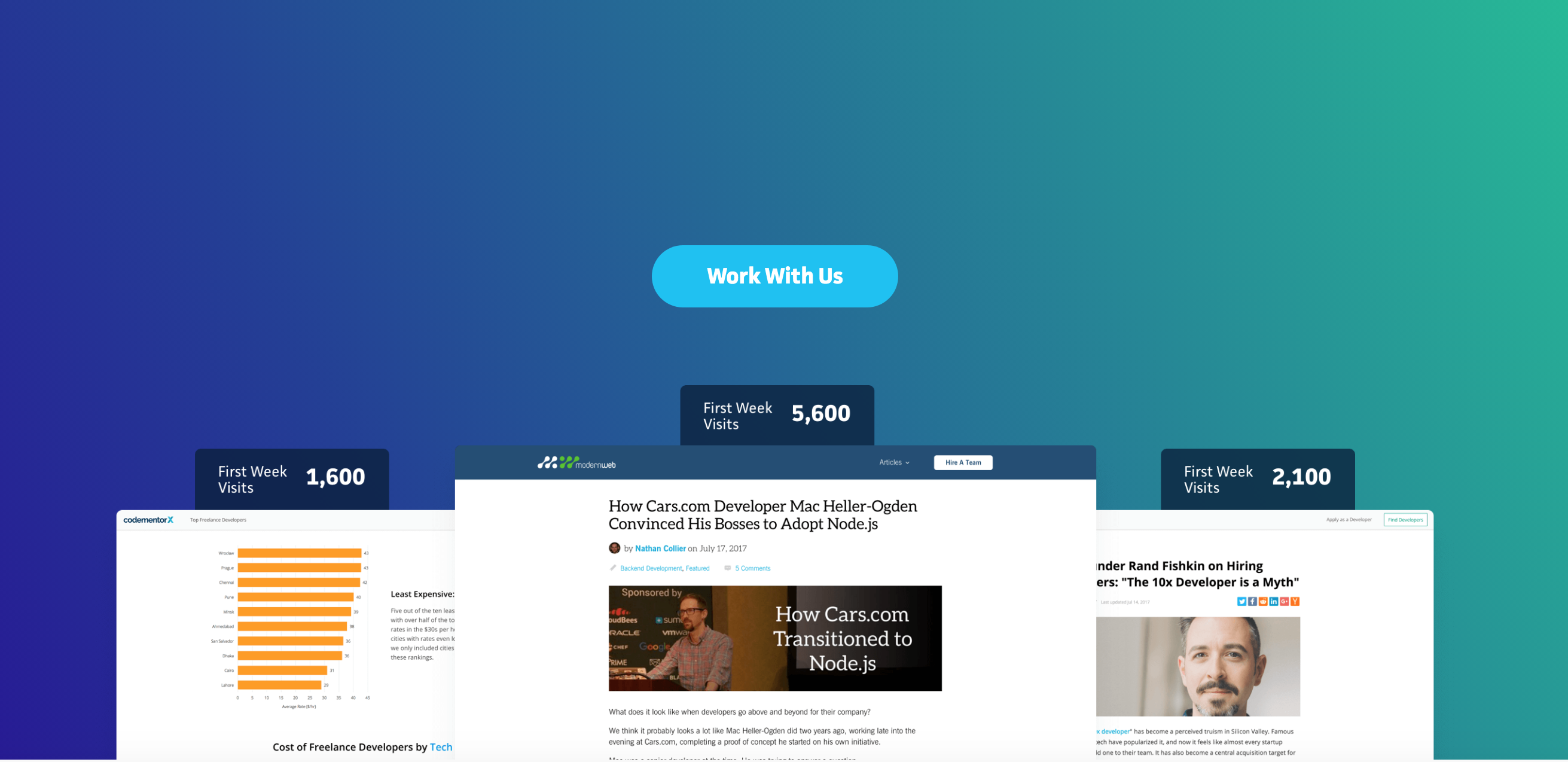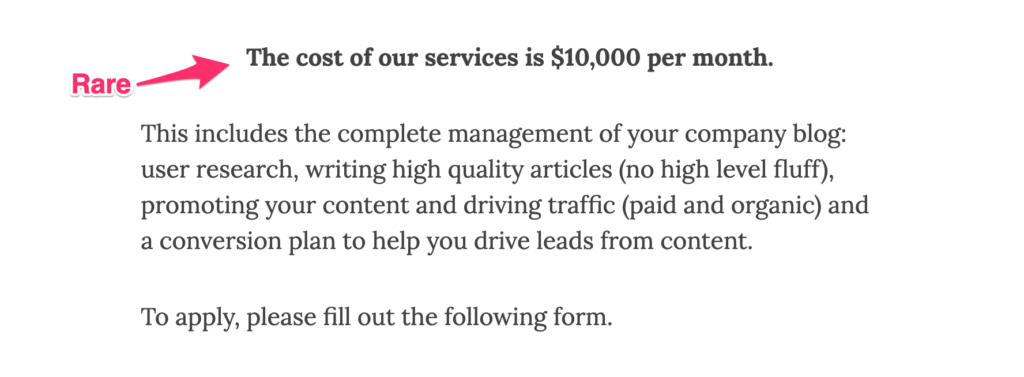Several months ago, we published an article titled “Positioning Is the Part of Product Market Fit You’re Likely Ignoring”. It was motivated by our feeling that our work was heavily dependent on clients getting their positioning right.
We define positioning as the “market fit” part of “product-market fit”:
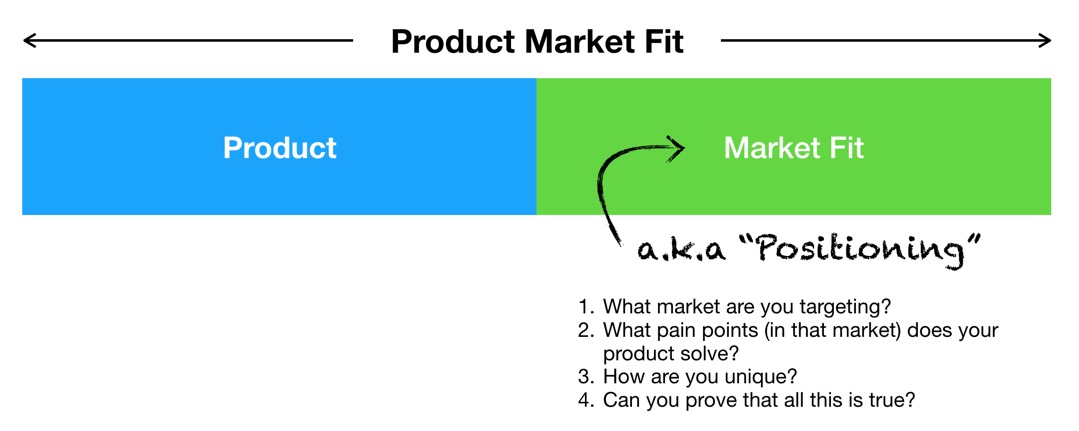
If your positioning isn’t dialed in, it causes a bunch of problems, but for marketing specifically, there are two big ones:
- Your conversion rate stays frustratingly low no matter what you do on the traffic generation side.
- You can’t set your prices as high as you’d like.
Companies with these issues end up not closing as many deals as they like (problem 1) and/or feel like the leads they do get can’t afford them (problem 2).
And here is the kicker: Most management teams end up pointing their finger at marketing tactics when they encounter this problem.
You’ll hear things like:
“X channel [facebook ads, linkedin ads, content, insert other acquisition channel] just doesn’t work for us”
…or…
“The traffic from content is just not converting into customers, we need to go [upmarket, different niche, optimize our conversions, etc.]”
But they’re barking up the wrong tree.
If your brand positioning is off, it won’t matter what inbound channel [paid, content, etc.] you use to get in front of your customer. The problem will be that the traffic you generate from the channel won’t convert or won’t pay what you want because you’re not positioned properly to demand those things.
Our Four Criteria for Getting Brand Positioning Right
In our positioning post, we also argue that simply stating your brand positioning as a brief phrase of who you’re targeting (“We make a CRM for small businesses”) isn’t enough. That’s not really positioning, it’s just a very broad initial target market statement.
We define 4 criteria you need to think about and demonstrate in your copy, your sales pitch, and your engagement to customers, to really have positioning done well:
- Who are you targeting?
- What pain points does your product solve?
- How are you unique?
- Can you prove the above is true?
If you miss on any of these criteria, there is a good chance you will suffer from some of the positioning based problems above (customers not closing, can’t charge enough).
Using Our Agency as a Positioning Case Study
Since publishing that article, we realized that our own agency can be a good example of positioning, especially if you look at it in terms of the two problems above: conversion rate and pricing.
- Conversion rate: Since starting our agency, we’ve generated on average a little over one new lead a week. Obviously a “good conversion rate” is very subjective, depending on traffic, industry, service, price point, size, growth goals and more. But for our size agency, that’s enough, and considering we have displayed our $10,000 price point in bold on our work with us page (very rare for agencies to do this at these prices), we think that’s pretty good. Our close rate is currently 14.3% on those leads, which we also are happy with because we offer a boutique service and don’t work with many clients at once.
- Pricing: One of the top questions I get from other agency owners is how we’re able to charge $10,000/month for our services. In particular with delivering “only” 3 articles per month to clients. The answer is positioning — in this case, we make it clear our lead and traffic results are what you should focus on, not publishing quantity.
In this article, I’ll go into detail on how we positioned our service and why, using the 4 criteria above as an anchor. We’ll cover who our target customer is, how we identified their pain points, and the differentiation that we have versus other content marketing agencies.
The goal of this post is to help other services businesses differentiate themselves from their competition and position themselves as a premium service instead of being lumped in with all of the other service providers out there.
Although we’re case studying ourselves — a service business — the underlying principles (be extremely judicious about identifying a gap in the market, positioning yourself as the solution for these pain points, knowing who you’re targeting with obsessive focus) apply equally well to product companies as well.
How We Identified a Gap in the Market
A lot of our positioning is based on Criteria 2: Pain Points. Even the first criteria, who we are targeting, stems largely from those pain points. We’ll start by telling the story of how the agency came to be, because that’s based on us experiencing pain points ourselves.
Before Grow and Convert: Identifying the Content Gap for ThinkApps
Before starting this agency, I ran marketing for a startup in San Francisco called ThinkApps. I joined the company as the first marketing hire and fourth employee. At that early stage, a marketer wears a lot of hats. My job was to test out various acquisition channels that would help us generate new leads for the service we offered (building apps).

The job started with redoing our positioning, messaging, and website. Then, we focused on paid ads and realized that our CAC (customer acquisition cost) was fairly high through paid channels. We tested doing educational events in San Francisco to drive awareness but most of the people who showed up didn’t have any money for services.
So, we turned to content.
I started by doing research on content in the app building space and realized there was an opportunity there — no one was writing helpful content on how to build mobile and web apps from start to finish.
Trying to Find a Content Agency That Was Willing to Be Held Accountable to Leads
Content was the next logical channel to test. The only problem was I had no time to do it all myself — I was also managing our paid channels, talking to inbound leads, and talking with customers. I’d done content marketing in-house before and knew how time intensive it would be to build out a team, so I decided to bring on a content marketing agency to work with. I started doing research online for agencies and setup calls with about 10 different companies.

What I wanted was an agency that could produce educational content that would be interesting/useful to our audience, drive traffic to it, and measure the results — essentially own the entire channel and be held accountable to results. I couldn’t find this type of content marketing agency, that is, one that’s held accountable to leads and traffic.
Gaps in Content, Promotion, and Lead Generation
The pitch for most of these agencies was that they’d produce ‘X’ articles per month and “promote the articles,” which essentially meant that they’d draft social media updates for you to share on your own social channels. To my amazement, these agencies were charging anywhere from $6k–10k+ per month.
When I asked how they created the content, they would say that had a team of writers that could write on any topic. I looked at some of the sample pieces of content, and while the topics looked alright, the writing was mostly mirage content.

Intro level content is fine if your customers are truly beginners on a topic. Typically this is appropriate for B2C companies. For example, if you sell yoga apparel and equipment, a huge majority of your customers will be beginners in yoga, so simple posts that any lay person freelance writer can Google their way to writing about yoga routines will be fine.
But for most B2B companies, your customers are experts in their niche. For example, if you sell security software to head of IT, they have been in IT for decades and know a lot about security software. How is a lay person (a freelance writer with surface level knowledge of IT) going to Google their way to posts that will impress and attract IT directors? They can’t. This is why you see company after company product “10 trends of 2019 in [niche]” posts all day. They don’t work. And I knew if I went this route I’d have to spend a ton of time editing, which I didn’t want to do.
When I asked how they measure results, they’d give me the same standard line (that most content marketers, including individuals also give) “well, over time, you’ll grow traffic from the content we’re writing and some subset of that traffic will turn into leads/customers.” That was a cop out, it meant they held themselves accountable to output (x pieces, y word count) — not results. I wanted leads, not articles.
So after a month of talking to different agencies and not finding one of them that offered the service that I wanted, I opted to build out our content marketing operation in-house. We built a team of freelance writers and brought on an editor. I handled our content strategy, promotion, and conversion efforts.
In a little over 6 months, we grew the blog to over 35,000 monthly unique visitors and the blog became the #1 acquisition source for the company.
To recap, here were the gaps in the market:
- No leads-driven content solutions: There weren’t any content marketing agencies that measured the same metrics that marketing departments are held accountable to (leads or signups generated).
- No good promotion strategies: None of these agencies had a promotion strategy beyond sharing content on that specific company’s social media accounts, and none could produce content at the level needed for this channel to be effective.
- Poor advanced content writing abilities: Finally, most writing services just deployed freelance writers to Google a topic and write up some intro-level piece on that topic. That works fine if your company sells to customers with a beginner-level understanding, but for most B2B and B2C companies, you need more advanced content to effectively communicate with your audience.
Filling the Gaps: How We Formulated Our Service Offering, Pricing, and Positioning
Devesh and I started this site as a way to teach the learnings that both of us had from our experiences in content marketing. I was sharing my learnings from hiring writers, content strategy, promotion, and conversion from ThinkApps and Vistage. Devesh was sharing his experience doing conversion optimization and measurement for people like Backlinko, Bryan Harris at Video Fruit, and a number of different SaaS and service companies.
When we started Grow and Convert, we both agreed we didn’t want to start an agency from the site. But after about 4 failed attempts trying to build a product company, we eventually couldn’t ignore the numerous requests from our audience to “just do content marketing for us”. So we opted to give a crack at a service business.
How We Came Up with Our Service Offering
Armed with the lessons about what most content marketing agencies were missing, we decided that we wanted to build the service that filled the gap we identified above.
Here are the things that we thought were important for our service to offer:
- A service that focused on results (driving leads and qualified traffic) and not just deliverables (like ‘X’ number of articles per month). [Gap 1 above]
- A service that produced content that was useful/helpful to the target customer (not just high-level Mirage Content or Google research papers written by freelancers with no knowledge on the topic, and therefore risked lacking Customer Content Fit). [Gap 3 above]
- A service that actually drove traffic to the pieces that we created — originally done solely through community content promotion (not just content shared through a companies social media channels). [Gap 2 above]
- A service that was transparent — as a client, you could see traffic and conversions at all times. There was always a way to reach us and ask questions. (Most of the other agencies kept you in the dark about results and were hard to get ahold of outside of a monthly or biweekly call.)
We drafted the original sales page in Google Docs outlining our service offering. Our goal was to have a lot of these principles shine through on the page. Here it is:
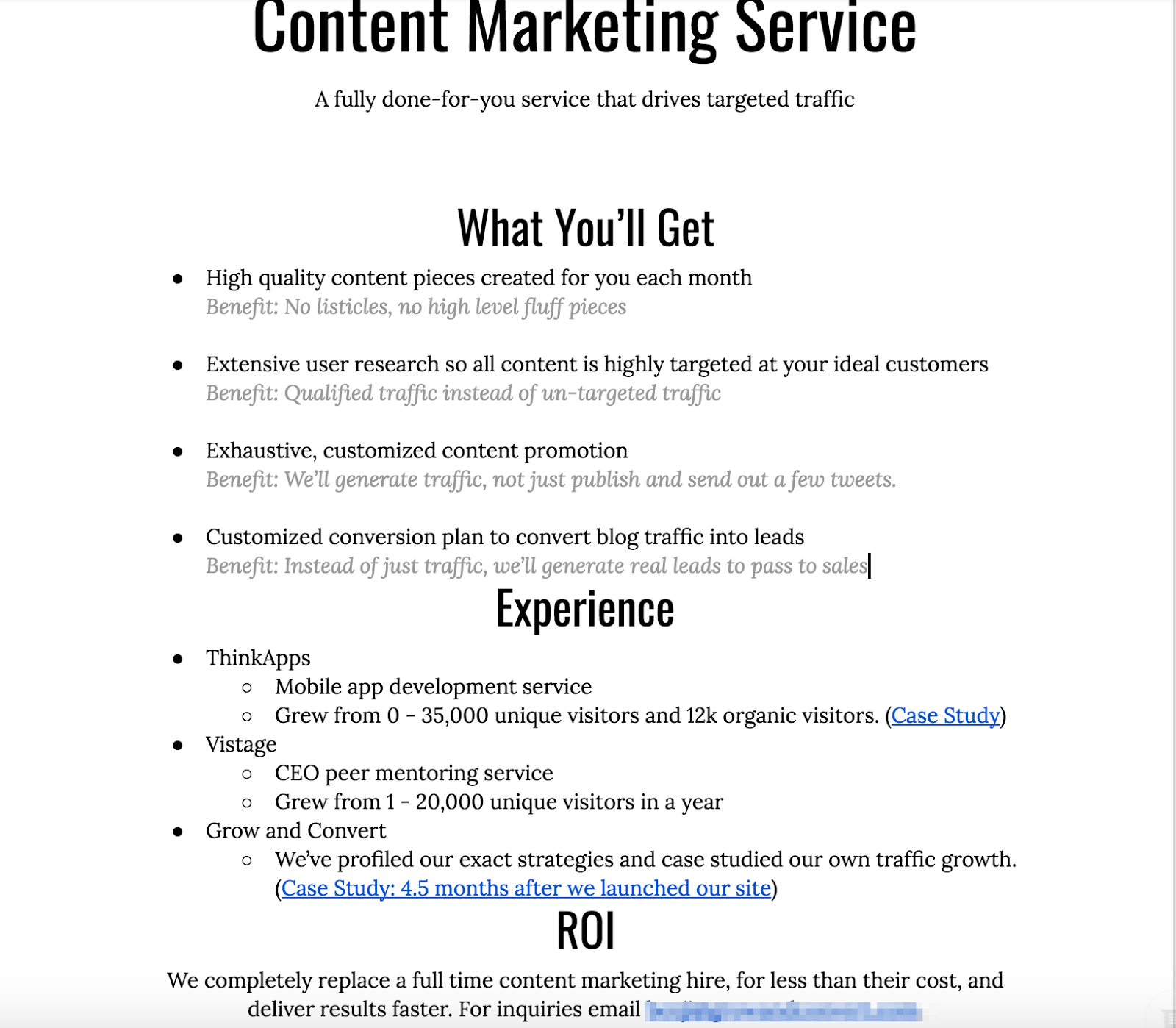
There were still a lot of unknowns in terms of how we were going to execute on all of this. At this stage, we didn’t have any writers, we had only vague ideas about how we were going to attribute leads to content, we didn’t have any systems or processes, and the only person that knew how to do promotion was me.
But at this stage, the only thing that was important to us was to validate our hypothesis: Companies wanted a content marketing service that was held accountable to traffic and leads, produced high quality content, and took care of all of the work for them, not just a writing service, and they were willing to pay a premium for it.
How We Came Up with Our Pricing
Speaking of premium, the next challenge for us was to figure out how much to charge.
The question we had to ask ourselves was:
“If we could live up to all of the promises we made in our pitch, what would we value this service at?”
I know it’s basic, but many people forget this: Price is a function of the perceived value of your service.
Having knowledge of what it costs to run a content marketing operation in-house, we started adding up all of the people/roles needed to make a successful operation.
What are the costs associated with an in-house content marketing operation:
- Mid/senior level content marketing manager ($80k–120k+): Someone who led the customer research efforts, content strategy, SEO strategy, coordinated all content marketing efforts, helped with promotion strategy and conversion strategy.
- (Optional) Full-time editor ($50k–120k): Note that this isn’t necessarily needed early on; you could also hire someone on a contract basis to do editing.
- Freelance writers ($250–1k/article): Costs associated to the content you need to produce.
- (Optional) Analytics consultant ($50–100/hr): To help measure attribution of your content marketing efforts.
- (Optional) Promotion person/promotion budget for paid if it’s not in the content marketing manager’s skill set ($1k–3k/month): To help drive traffic to the articles produced.
- (Optional) SEO strategist consultant: Full time: same range as content marketing manager; part time: $3k–5k/month.
- (Optional) Developer time. Inevitably, every content operation needs dev time and many readers know it can be a struggle for the marketing department to get this time from the main developers (who are busy with “core” work). So to circumvent this, they need budget for freelance developers of their own.
If we added up all the costs of the team to make a content marketing operation successful — on the low end, you’re looking at around $100k per year just for the content marketing manager and writers (cost of pieces), and even that is not including benefits, healthcare, etc. Then, on the high end, with many of the bullets mentioned above, you’re looking at around $300k–500k per year.
At first, when we listed out all these responsibilities, I had a flashback to how hard it was to build this in my previous companies and flat out said no. I told Devesh it’s just too much work and people don’t understand that and their expectations won’t be realistic. Devesh said “Ok, but at some price, it’s worth it. What’s that price?”
I blurted out “$10,000 a month”.
We figured that’s high, but not unreasonably high. There are agencies roughly in the same space charging that much. But not many companies can get that kind of content budget approved. In addition, we had zero client history, so were essentially unproven.
We discussed and settled at $6,000 per month. That’s a rate many companies are used to paying different agencies, and we figured if we can make this work, we can grow to $7,000 per month, then $8,000 per month, and beyond.
Plus, this translated to $72,000 per year, which we felt was a steal compared to the “do it in house” costs above. So we knew we could explain that value proposition in a sales call pretty well.
On top of that, we knew (from talking to many G&C readers at that point) that most marketing heads or founders aren’t happy with the results they’re getting from the content marketing they’re doing in house. They either aren’t happy with the content they’re producing, they don’t know if they’re actually getting leads/customers from content, they don’t have a way to drive traffic to articles, and many times don’t have a strategy in place to acquire new business from the channel.
So if we were to (1) price competitively against the other options companies have, and (2) provide better results than they’d get through these alternative options, it should be a no-brainer to work with us.
But we needed to validate this hypothesis.
When we launched that Google Doc landing page above and emailed our list about our service offering, we landed our first two clients in a matter of weeks — we were in business!
How This All Translates Into Our Positioning
Let’s recap here:
- At this point, we figured out the gap that other agencies weren’t offering (content marketing agencies that were held accountable to results).
- We figured out what was wrong with most in-house operations (it’s expensive to execute on and most companies aren’t happy with the results they’re producing).
- We figured out a service offering based on what was needed in the market (an agency that was responsible for producing a great content strategy that actually drives results and provides full transparency throughout the process).
- We determined the pricing that we thought people were willing to pay based on alternative options to them in the market.
- All of this was validated with real customers who agreed that all of the above hypotheses were correct.
Our Agency Positioning Based on the 4 Criteria
I’ll walk through our 4 positioning criteria to illustrate how we choose the clients that we work with, what pain points we solve in the market, how we’re unique, and how we can prove all of this to be true.
Criteria 1: What market are we targeting? (i.e., who are our best clients)
In our original positioning article, we introduce the wide vs. narrow problem for this criteria: do you narrow down to a specific segment or keep it wide and have other things (like specific pain point solutions) be your differentiator?
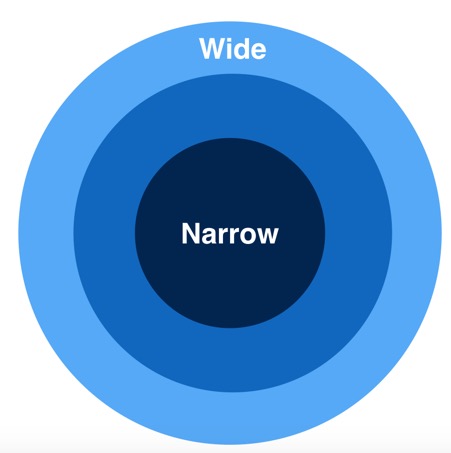
Our answer for this agency is actually kind of subtle.
We are wide in vertical (we’ve had very B2B clients like marketing and development agencies, clients like Cognitive FX, a concussion treatment center that treats individuals, and everything in between), but we are narrow in specific characteristics that stem from Criteria 2: pain points.
That’s why we spent the bulk of this article telling the story of identifying the gap in the market. Our narrow-ness in who we’re targeting is all around criteria that indicate that they resonate with the pain points we solve (i.e. the gaps we identified).
Our current working hypothesis of our best customers is as follows:
- They need to have a substantial amount of customers (this is subjective, but shows us that the business/model is somewhat already proven. It’s a criteria many agencies use and is sort of a basic “ticket of entry” criteria.)
- They need to have an existing sales or marketing channel that works (We want to make sure the company has already proven that they know how to sell into accounts [service] or can drive signups [SaaS]. This ensures the leads we generate can be closed.)
- They have typically tried content marketing already and understand the difficulties/expectations and are looking for help from a 3rd party (i.e., they understand the pain points above).
- Have medium to high readability (people are interested in reading about the topic and/or do research prior to buying).
Criteria 2: What pain points does our service solve?
We discussed this at length in the sections above, but to recap:
- Most content solutions don’t hold themselves accountable to leads.
- Most cannot write on advanced topics that require specialized knowledge.
- Most don’t have a thorough promotion process.
Which takes us to our uniqueness…
Criteria 3: How are we unique?
As the gap identification section above outlined, the fact that we solve the above pain points as a single service provider is what sets us apart. Specifically:
- We’re accountable for leads generated. We’re held accountable to the results delivered (ie. leads and traffic). Most other agencies focus on deliverables or just traffic growth and aren’t willing to be held accountable to real business metrics. Our service aligns to the outcomes that our customers want — they want to create great content that also drives ROI.
- We’re able to cover advanced topics. We limit ourselves to 3 posts per month so that we can keep them extremely high quality and focused. Our system has produced highly specialized pieces that lay people could not write by themselves, like neuroplasticity treatment for concussions, how Cars.com transitioned their backend framework to node.js, how to use a content delivery network to execute on the burgeoning “Edge SEO” concept, various posts on how hard money lending in real estate works, and more. It’s really hard to find writers or agencies that can do all of these. I can’t emphasize this enough: If your customer is advanced in any topic like this, having writers produce beginner level content in your space is not going to impress your customers.
- We have a solid promotion strategy. We have a 3 step promotion process including:
- community content promotion
- paid facebook promotion (that comes out of our budget)
- targeted link building for SEO
Again, it’s virtually impossible to find a single employee or agency that does all of this in addition to writing advanced-level content.
We simply don’t know of another agency that does all of this, nor of a single person you could hire that would do all of this and only cost your company $10,000 per month.
Criteria 4: How could we prove that our positioning was true?
The proof is easy when your company is based on content.
Since starting Grow and Convert, we now have a bunch of case studies, some of which are published here, and some of which are emailed to prospects after talking with them.
At the time of starting the agency, this wasn’t as strong. But it wasn’t zero. We had success stories from past work we did. If you’re starting a new business, you won’t be strong here… that’s normal. You’ll need to find ways to get your first few customers so you can build up the proof. At that point though, you need to figure out how you’re going to convey that proof (either through content marketing or some other strategy).
Here are some examples of what we did early on to show proof:
- We shared case studies of our promotion techniques.
- We shared case studies of our conversion tactics.
- We did a live challenge of us growing this site from scratch — to prove that we knew what we were doing in content marketing.
- We gave talks and did podcast interviews about content marketing strategies and case studies.
What Other Companies Should Take Away From This Post
If you’re getting in front of customers but it’s not easy to sell them your product or service, you likely suffer from a positioning issue.
We know how hard positioning is to get right because we’ve been through 4 pivots ourselves to get to all of the insights about what works for us.
If it’s not easy to sell your product or service, as in, you get leads but no one is purchasing, you likely suffer from one of these issues:
- Your product or service doesn’t solve a real problem for your customer.
- You’re selling to the wrong customer.
- There is nothing truly unique about your product or service.
- You’re not explaining what your product or service does in a clear and concise manner.
- It’s not easy for someone to prove that the solution you created would work for them.
You can find out which issue you’re facing by talking to prospects that were interested and didn’t convert, asking customers that churned, and asking people in your target segment why they’re not interested in your product or service and why they didn’t purchase.
The answers are always humbling and you’ll get closer to figuring out what will work better for your business.
To figure out how to strengthen your positioning against competitors, you should continually ask yourself:
- What problem can my product or service solve better than anyone else?
- What do my customers want my product or service to do that no one else is doing?
- What do my customers think would be better than everything else out there?
- What pain points do my customers want me to solve that I’m not solving currently?
- Does my promise to my customers (i.e., what you say your product or service does) live up to the product or service that I’m offering?
- How can I get better in the eyes of my customers?
Questions? Comments? Feel free to ask them in the comments below.

